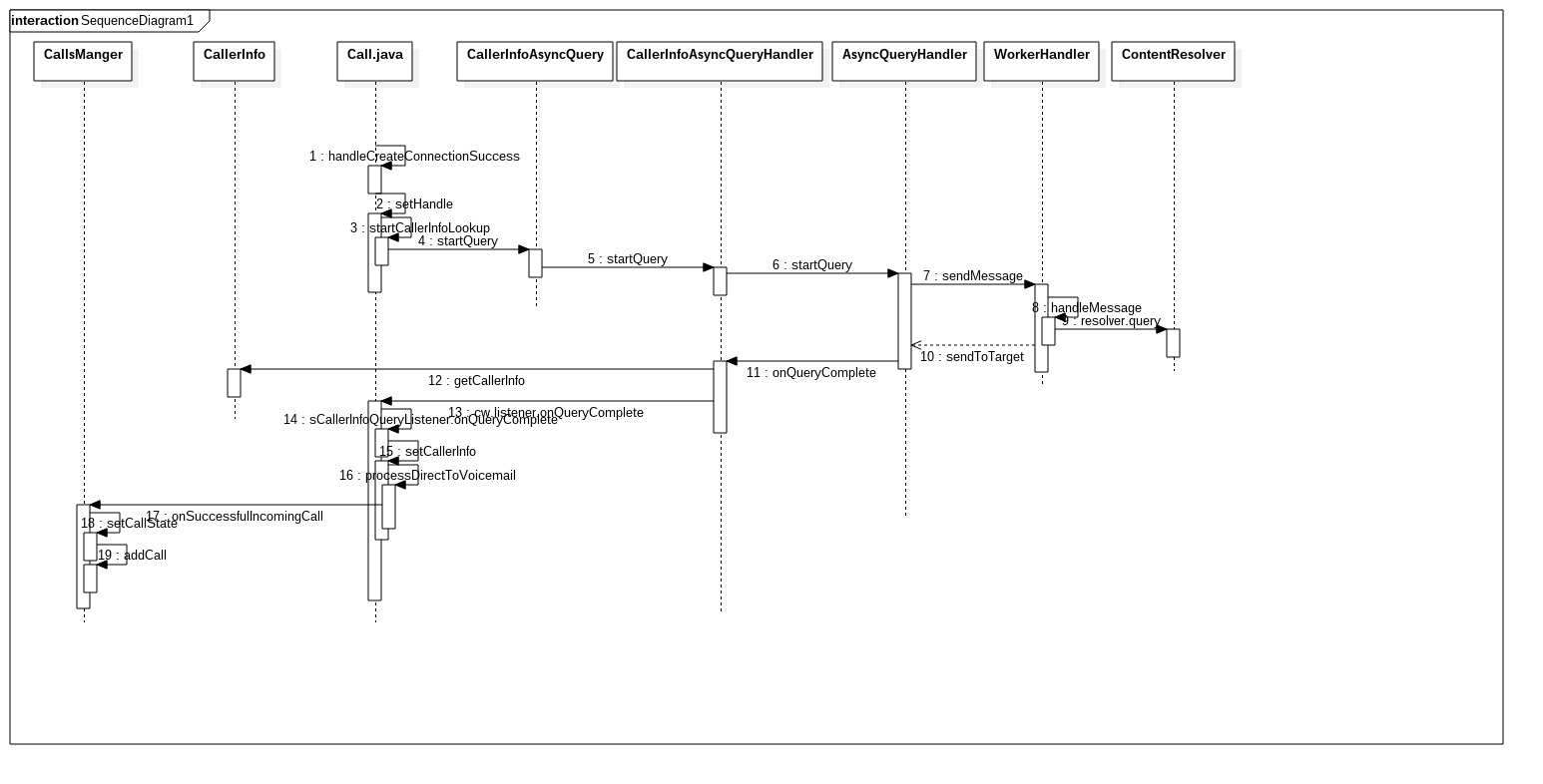Android6.0來電號碼電話薄名稱匹配
本文將介紹系統接收到來電之後,如何在電話薄中進行匹配聯絡人的流程。分析將從另外一篇文章(基於Android6.0的RIL框架層模組分析)中提到的與本文內容相關的程式碼開始。
//packages/service/***/Call.java
public void handleCreateConnectionSuccess(
CallIdMapper idMapper,
ParcelableConnection connection) {
setHandle(connection.getHandle(), connection.getHandlePresentation()); 這個setHandle函式如下:
//Call.java
public void setHandle(Uri handle, int presentation) {
startCallerInfoLookup();
}
private void startCallerInfoLookup() {
final String number = mHandle == null ? null : mHandle.getSchemeSpecificPart();
mQueryToken++; // Updated so that previous queries can no longer set the information.
mCallerInfo = null;
if (!TextUtils.isEmpty(number)) {
mHandler.post(new Runnable() {
@Override
public void run() {
mCallerInfoAsyncQueryFactory.startQuery(mQueryToken,
mContext,number,mCallerInfoQueryListener,Call.this);
}});
}
}
注意後面post的那個Runnable。這個就是啟動查詢號碼的邏輯了。這個mCallerInfoAsyncQueryFactory的賦值的流程比較曲折。在TelecomService被連線上呼叫onBind的時候,會呼叫initializeTelecomSystem函式。那這個TelecomService是在哪裡被啟動的呢?在TelecomLoaderService.java裡面定義了:
private static final ComponentName SERVICE_COMPONENT = new ComponentName(
"com.android.server.telecom",
"com.android.server.telecom.components.TelecomService");
private void connectToTelecom() {
synchronized (mLock) {
TelecomServiceConnection serviceConnection = new TelecomServiceConnection();
Intent intent = new Intent(SERVICE_ACTION);
intent.setComponent(SERVICE_COMPONENT);
// Bind to Telecom and register the service
if (mContext.bindServiceAsUser(intent, serviceConnection, flags, UserHandle.OWNER)) {
mServiceConnection = serviceConnection;
} }}
public void onBootPhase(int phase) {//這個在系統啟動階段就會觸發
if (phase == PHASE_ACTIVITY_MANAGER_READY) {
connectToTelecom();
}}
所以從這裡看,在系統啟動階段就會觸發TelecomService這個service,且在成功連線到服務之後,將呼叫ServiceManager.addService(Context.TELECOM_SERVICE, service),將這個服務新增到系統服務中了。這個類的建構函式中,在呼叫函式initializeTelecomSystem初始化TelecomSystem時,就例項化了一個內部匿名物件,並且在TelecomSystem的建構函式中初始化一個mCallsManager時將該匿名物件傳入,而在CallsManager的processIncomingCallIntent中會用這個函式初始化一個Call物件。所以這個mCallerInfoAsyncQueryFactory的實際內容見TelecomService中的initializeTelecomSystem:
//TelecomService.java
TelecomSystem.setInstance(
new TelecomSystem(
context,
new MissedCallNotifierImpl(context.getApplicationContext()),
new CallerInfoAsyncQueryFactory() {
@Override
public CallerInfoAsyncQuery startQuery(int token, Context context,
String number,CallerInfoAsyncQuery.OnQueryCompleteListener listener,
Object cookie) {
return CallerInfoAsyncQuery.startQuery(token, context, number, listener, cookie);
}},
new HeadsetMediaButtonFactory() {},
new ProximitySensorManagerFactory() {},
new InCallWakeLockControllerFactory() {},
new ViceNotifier() {}));
可以看到,通過startQuery來查詢傳入的number的動作。我們來看看CallerInfoAsyncQuery的startQuery函式。
//frameworks/base/telephony/java/com/android/internal/CallerInfoAsyncQuery.java
/**
* Factory method to start the query based on a number.
*
* Note: if the number contains an "@" character we treat it
* as a SIP address, and look it up directly in the Data table
* rather than using the PhoneLookup table.
* TODO: But eventually we should expose two separate methods, one for
* numbers and one for SIP addresses, and then have
* PhoneUtils.startGetCallerInfo() decide which one to call based on
* the phone type of the incoming connection.
*/
public static CallerInfoAsyncQuery startQuery(int token, Context context, String number,
OnQueryCompleteListener listener, Object cookie) {
int subId = SubscriptionManager.getDefaultSubId();
return startQuery(token, context, number, listener, cookie, subId);
}
/**
* Factory method to start the query with a Uri query spec.
*/
public static CallerInfoAsyncQuery startQuery(int token, Context context, Uri contactRef,
OnQueryCompleteListener listener, Object cookie) {
c.mHandler.startQuery(token,
cw, // cookie
contactRef, // uri,注意這裡的查詢地址
null, // projection
null, // selection
null, // selectionArgs
null); // orderBy
return c;
}
注意看註釋,該函式還會對SIP號碼(包含@的號碼)進行處理,還有緊急號碼和語音郵箱號碼進行區分。實際上,當對一個號碼進行查詢的時候,這三個startQuery都用到了。注意,上面的startQuery會根據結果對connection的值進行修改。
其中將號碼轉換成uri格式的資料,後續會對這個資料進行查詢:
//frameworks/base/***/CallerInfoAsyncQuery.java
public static CallerInfoAsyncQuery startQuery(int token, Context context, String number, OnQueryCompleteListener listener, Object cookie, int subId) {
// Construct the URI object and query params, and start the query.
final Uri contactRef = PhoneLookup.ENTERPRISE_CONTENT_FILTER_URI.buildUpon().appendPath(number)
.appendQueryParameter(PhoneLookup.QUERY_PARAMETER_SIP_ADDRESS, String.valueOf(PhoneNumberUtils.isUriNumber(number)))
.build();
CallerInfoAsyncQuery c = new CallerInfoAsyncQuery();
c.allocate(context, contactRef);
//create cookieWrapper, start query
CookieWrapper cw = new CookieWrapper();
cw.listener = listener; cw.cookie = cookie;
cw.number = number; cw.subId = subId;
// check to see if these are recognized numbers, and use shortcuts if we can.
if (PhoneNumberUtils.isLocalEmergencyNumber(context, number)) {
cw.event = EVENT_EMERGENCY_NUMBER;
} else if (PhoneNumberUtils.isVoiceMailNumber(subId, number)) {
cw.event = EVENT_VOICEMAIL_NUMBER;
} else {
cw.event = EVENT_NEW_QUERY;
}
c.mHandler.startQuery(token,
cw, // cookie
contactRef, // uri
null, // projection
null, // selection
null, // selectionArgs
null); // orderBy
return c;
}
這個函式裡面的contactRef的值應該是“content://com.android.contacts/phone_lookup_enterprise/13678909678/sip?”類似的。
實際上這個query是呼叫CallerInfoAsyncQueryHandler的startQuery函式,而這個函式是直接呼叫它的父類AsyncQueryHandler的同名函式。
//AsyncQueryHandler.java
public void startQuery(int token, Object cookie, Uri uri,
String[] projection, String selection, String[] selectionArgs,
String orderBy) {
// Use the token as what so cancelOperations works properly
Message msg = mWorkerThreadHandler.obtainMessage(token);
msg.arg1 = EVENT_ARG_QUERY;
WorkerArgs args = new WorkerArgs();
args.handler = this;
args.uri = uri;
msg.obj = args;
mWorkerThreadHandler.sendMessage(msg);
}
這個mWorkerThreadHandler是在CallerInfoAsyncQueryHandler函式覆寫父類的createHandler函式中賦值,是CallerInfoWorkerHandler型別。所以後續的處理函式是該類的handleMessage函式。
//AsyncQueryHandler.java
public void handleMessage(Message msg) {
WorkerArgs args = (WorkerArgs) msg.obj;
CookieWrapper cw = (CookieWrapper) args.cookie;
if (cw == null) {
// Normally, this should never be the case for calls originating
// from within this code.
// However, if there is any code that this Handler calls (such as in
// super.handleMessage) that DOES place unexpected messages on the
// queue, then we need pass these messages on.
} else {
switch (cw.event) {
case EVENT_NEW_QUERY://它的值跟AsyncQueryHandler的EVENT_ARG_QUERY一樣,都是1
//start the sql command.
super.handleMessage(msg);
break;
case EVENT_END_OF_QUEUE:
// query was already completed, so just send the reply.
// passing the original token value back to the caller
// on top of the event values in arg1.
Message reply = args.handler.obtainMessage(msg.what);
reply.obj = args;
reply.arg1 = msg.arg1;
reply.sendToTarget();
break;
default:
}}}}
這個super就是AsyncQueryHandler的內部類WorkerHandler了。
//AsyncQueryHandler.java
protected class WorkerHandler extends Handler {
@Override
public void handleMessage(Message msg) {
final ContentResolver resolver = mResolver.get();
WorkerArgs args = (WorkerArgs) msg.obj;
int token = msg.what;
int event = msg.arg1;
switch (event) {
case EVENT_ARG_QUERY:
Cursor cursor;
try {
cursor = resolver.query(args.uri, args.projection,
args.selection, args.selectionArgs,
args.orderBy);
// Calling getCount() causes the cursor window to be filled,
// which will make the first access on the main thread a lot faster.
if (cursor != null) {
cursor.getCount();
}}
args.result = cursor;
break;
}
// passing the original token value back to the caller
// on top of the event values in arg1.
Message reply = args.handler.obtainMessage(token);
reply.obj = args;
reply.arg1 = msg.arg1;
reply.sendToTarget();
}}
可以看到流程就是簡單的用resolver.query來查詢指定的query URI,然後將返回值通過訊息機制傳送到AsyncQueryHandler的handleMessage裡面處理,而在這裡會呼叫CallerInfoAsyncQuery的onQueryComplete函式。注意這個ContentResolver是在uri上查詢結果,而這個uri是由某個ContentProvider來提供的。注意這個地址裡面的authorities裡面的值為”com.android.contacts”,同樣看看ContactsProvider的androidmanifest.xml檔案:
<provider android:name="ContactsProvider2"
android:authorities="contacts;com.android.contacts"
android:readPermission="android.permission.READ_CONTACTS"
android:writePermission="android.permission.WRITE_CONTACTS">
<path-permission android:pathPrefix="/search_suggest_query"
android:readPermission="android.permission.GLOBAL_SEARCH" />
<path-permission android:pathPattern="/contacts/.*/photo" android:readPermission="android.permission.GLOBAL_SEARCH" />
<grant-uri-permission android:pathPattern=".*" />
</provider>
所以最後這個查詢是由ContactsProvider來執行的。
我們來看看查詢完成之後,呼叫CallerInfoAsyncQuery的onQueryComplete函式的具體流程:
protected void onQueryComplete(int token, Object cookie, Cursor cursor) {
// check the token and if needed, create the callerinfo object.
if (mCallerInfo == null) {
if (cw.event == EVENT_EMERGENCY_NUMBER) {
} else if (cw.event == EVENT_VOICEMAIL_NUMBER) {
} else {
mCallerInfo = CallerInfo.getCallerInfo(mContext, mQueryUri, cursor);
}
}
}
//notify the listener that the query is complete.
if (cw.listener != null) {
cw.listener.onQueryComplete(token, cw.cookie, mCallerInfo);
}
}
}
注意,上面程式碼裡面的CallerInfo.getCallerInfo非常重要。在這裡面會使用查詢處理的cursor結果,並將合適的結果填充到mCallerInfo,將其傳遞到cw.listener.onQueryComplete函式中,作為最終結果進行進一步處理。
//CallerInfo.java
public static CallerInfo getCallerInfo(Context context, Uri contactRef, Cursor cursor) {
CallerInfo info = new CallerInfo();
if (cursor != null) {
if (cursor.moveToFirst()) {
columnIndex = cursor.getColumnIndex(PhoneLookup.LOOKUP_KEY);
if (columnIndex != -1) {
info.lookupKey = cursor.getString(columnIndex);
}
info.contactExists = true;
}
cursor.close();
cursor = null;
}
info.needUpdate = false;
info.name = normalize(info.name);
info.contactRefUri = contactRef;
return info;
}
系統原生的邏輯是取搜尋結果的第一個記錄,並用來例項化。當客戶需求改變,需要匹配不同號碼的時候,就需要修改這個地方的了。最優先是遍歷整個cursor集合,並且根據客戶需求選出適合的結果,賦值給CallerInfo例項。
下面是整個號碼匹配的流程圖:
Call.java會將查詢後的結果設定到Call例項裡面,並將其傳送到CallsManager裡面進行後續處理。而這個CallsManager會將這個Call顯示給客戶。
當網路端來電時,frame層會接收到,並且連線成功之後會觸發Call.java裡面的handleCreateConnectionSuccess。這個函式邏輯是從資料庫中查詢複合要求的聯絡人,並且只取結果集的第一條記錄,用來初始化這個Call裡面的變數。而後將這個Call傳到CallsManager進行處理,顯示給使用者。

